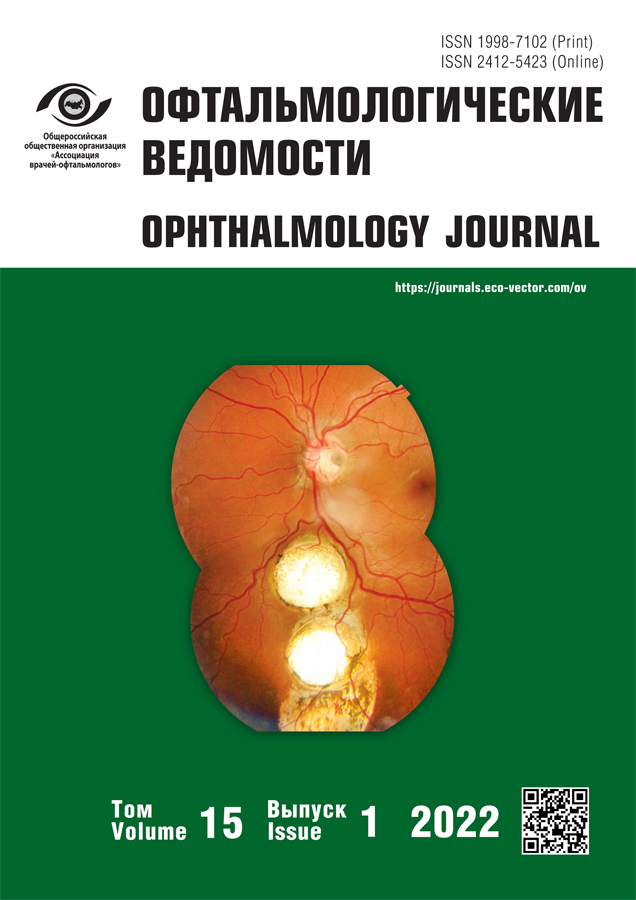Клинический случай развития хориоидальной неоваскуляризации у пациентки с меланомой кожи на фоне терапии ингибиторами MEK и BRAF
- Авторы: Ткаченко Н.В.1, Белехова С.Г.1, Жукова Н.В.2,3, Прокопчук В.С.1, Чернова Н.С.4
-
Учреждения:
- Первый Санкт-Петербургский государственный медицинский университет им. акад. И.П. Павлова
- Санкт-Петербургский государственный университет
- Городской клинический онкологический диспансер
- Национальный медицинский исследовательский центр им. В.А. Алмазова
- Выпуск: Том 15, № 1 (2022)
- Страницы: 77-85
- Раздел: Клинические случаи
- Статья получена: 02.05.2022
- Статья одобрена: 15.05.2022
- Статья опубликована: 10.06.2022
- URL: https://journals.eco-vector.com/ov/article/view/107047
- DOI: https://doi.org/10.17816/OV107047
- ID: 107047
Цитировать
Полный текст
Аннотация
Появление таргетной терапии стало существенным прорывом в ведении пациентов онкологического профиля, но даже она не лишена недостатков. В статье описан клинический случай развития хориоидальной неоваскуляризации у пациентки 42 лет с меланомой кожи IV стадии на фоне 15 месяцев терапии ингибиторами MEK и BRAF. Клиницистам необходимо помнить, что у таких пациентов возможно появление не только МЕK-ассоциированной ретинопатии, но и других патологических изменений сетчатки, в частности, хориоидальной неоваскуляризации, которые могут быть связаны как с получаемой ими терапией, так и с самим паранеопластическим синдромом на фоне течения основного заболевания. Своевременная диагностика и адекватная тактика ведения позволяют сохранить зрительные функции таким больным.
Ключевые слова
Полный текст
Об авторах
Наталья Викторовна Ткаченко
Первый Санкт-Петербургский государственный медицинский университет им. акад. И.П. Павлова
Email: natalyatkachenko@yandex.ru
SPIN-код: 5187-3670
канд. мед. наук
Россия, Санкт-ПетербургСветлана Георгиевна Белехова
Первый Санкт-Петербургский государственный медицинский университет им. акад. И.П. Павлова
Автор, ответственный за переписку.
Email: beleksv@yandex.ru
ORCID iD: 0000-0003-0293-4811
SPIN-код: 3637-7441
канд. мед. наук
Россия, Санкт-ПетербургНаталья Владимировна Жукова
Санкт-Петербургский государственный университет; Городской клинический онкологический диспансер
Email: drnvz@yandex.ru
ORCID iD: 0000-0002-0619-2205
SPIN-код: 3480-2098
канд. мед. наук, доцент кафедры онкологии, заведующая химиотерапевтическим отделением
Россия, Санкт-Петербург; Санкт-ПетербургВера Сергеевна Прокопчук
Первый Санкт-Петербургский государственный медицинский университет им. акад. И.П. Павлова
Email: prokopchuk.vera98@gmail.com
ORCID iD: 0000-0003-3310-6234
студентка
Россия, Санкт-ПетербургНаталья Сергеевна Чернова
Национальный медицинский исследовательский центр им. В.А. Алмазова
Email: demod@list.ru
врач-офтальмолог
Россия, Санкт-ПетербургСписок литературы
- Gianni L., Panzini I., Li S., et al. Ocular toxicity during adjuvant chemoendocrine therapy for early breast cancer: results from International Breast Cancer Study Group trials // Cancer. 2006. Vol. 106, No. 3. P. 505–513. doi: 10.1002/cncr.21651
- Bindiganavile S., Bhat N., Lee A.G., et al. Targeted Cancer Therapy and Its Ophthalmic Side Effects: A Review // J Immunother Precis Oncol. 2021. Vol. 4, No. 1. P. 6–15. doi: 10.36401/JIPO-20-21
- Ho W.L., Wong H., Yau T. The ophthalmological complications of targeted agents in cancer therapy: what do we need to know as ophthalmologists? // Acta Ophthalmol. 2013. Vol. 91, No. 7. P. 604–609. doi: 10.1111/j.1755-3768.2012.02518
- Liu С.Y., Francis J.H., Abramson D.H. Ocular side effects of systemically administered chemotherapy [Интернет]. UpToDate, 2022. Доступ по ссылке: https://www.uptodate.com/contents/ocular-side-effects-of-systemically-administered-chemotherapy/print
- Camidge D.R., Bang Y.-J., Kwak E.L., et al. Activity and safety of crizotinib in patients with ALK-positive non-small-cell lung cancer: updated results from a phase 1 study // Lancet Oncol. 2012. Vol. 13, No. 10. P. 1011–1019. doi: 10.1016/S1470-2045(12)70344-3
- Saleh M., Bourcier T., Noel G., et al. Bilateral macular ischemia and severe visual loss following trastuzumab therapy // Acta Oncol. 2011. Vol. 50, No. 3. P. 477–478. doi: 10.3109/0284186X.2011.555781
- De la Cruz-Merino L., Di Guardo L., Grob J.-J., et al. Clinical features of serous retinopathy observed with cobimetinib in patients with BRAF-mutated melanoma treated in the randomized coBRIM study // J Transl Med. 2017. Vol. 15. ID146. doi: 10.1186/s12967-017-1246-0
- Stjepanovic N, Velazquez-Martin JP, Bedard PL. Ocular toxicities of MEK inhibitors and other targeted therapies // Ann Oncol. 2016. Vol. 27, No. 6. P. 998–1005. doi: 10.1093/annonc/mdw100
- Méndez-Martínez S., Calvo P., Ruiz-Moreno O., et al. Ocular adverse events associated with MEK inhibitors // Retina. 2019. Vol. 39, No. 8. P. 1435–1450. doi: 10.1097/IAE.0000000000002451
- Urner-Bloch U., Urner M., Jaberg-Bentele N., et al. MEK inhibitor-associated retinopathy (MEKAR) in metastatic melanoma: Long-term ophthalmic effects // Eur J Cancer. 2016. Vol. 65. P. 130–138. doi: 10.1016/j.ejca.2016.06.018
- Francis J.H., Habib L.A., Abramson D.H., et al. Clinical and Morphologic Characteristics of MEK Inhibitor-Associated Retinopathy: Differences from Central Serous Chorioretinopathy // Ophthalmology. 2017. Vol. 124, No. 12. P. 1788–1798. doi: 10.1016/j.ophtha.2017.05.038
- De la Cruz-Merino L., Di Guardo L., Grob J.J., et al. Clinical features of serous retinopathy observed with cobimetinib in patients with BRAF-mutated melanoma treated in the randomized coBRIM study // J Transl Med. 2017. Vol. 15. ID146. doi: 10.1186/s12967-017-1246-0
- Tyagi P., Santiago C. New features in MEK retinopathy // BMC Ophthalmol. 2018. Vol. 18. ID221. doi: 10.1186/s12886-018-0861-8
- Albertini G.C., Corbelli E., Battaglia Parodi M., Bandello F. Choroidal Neovascularization in Multifocal Choroiditis after Dabrafenib and Trametinib // Eur J Ophthalmol. 2017. Vol. 27, No. 6. P. e184–e186. doi: 10.5301/ejo.5001013
- Modjtahedi B.S., Maibach H., Park S. Multifocal bilateral choroidal neovascularization in a patient on ipilimumab for metastatic melanoma // Cutan Ocul Toxicol. 2013. Vol. 32, No. 4. P. 341–343. doi: 10.3109/15569527.2013.781618
- Al-Tweigeri T., Nabholtz J.-M., Mackey J.R. Ocular toxicity and cancer chemotherapy. A review // Cancer. 1996. Vol. 78, No. 7. P. 1359–1373. doi: 10.1002/(SICI)1097–0142(19961001)78:7<1359:: AID-CNCR1>3.0.CO;2-G
- Velez-Montoya R., Olson J.L., Petrash M.J., et al. Acute Onset Central Serous Retinopathy In Association With Mek Inhibitor Use For Metastatic Cancer // Invest Ophthal Vis Sci. 2011. Vol. 52. P. 2153–2153.
Дополнительные файлы














